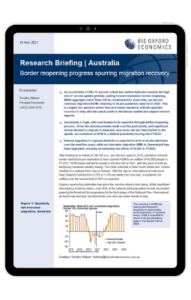Australia | Border reopening progress spurring migration recovery

After holding at an inflow of 246,300 p.a. over the four years to 2019, pandemic induced border restrictions are estimated to have pushed NOM to an outflow of 96,000 people in FY2021. NOM losses started to recede in the first half of 2021, with the pace of exits by temporary residents steadily easing. The Delta outbreak in New South Wales and Victoria resulted in a setback from July to October.
What you will learn:
- With the cap on international arrivals (excl. New Zealand) halving from 6,370 to 3,185 per week from mid-July, a sustained net outflow over the second half of 2021 is expected.
- Internal migration to regional Australia is expected to hold at an elevated base over the next few years, while net interstate migration (NIM) to Queensland has been upgraded, reaching an estimated net inflow of 35,000 in FY2022.
- Uncertainty is high, with road bumps to be expected throughout the reopening process. Given the announcements made over the past month, and significant stored demand to migrate to Australia, near-term risk has tilted further to the upside.
Tags:
Related Services

Post
US Rolls Up Welcome Mat for International Travel
Research Briefing Australia | Border reopening progress spurring migration recovery Trump tariffs set to raise effective rate above 1930s levels.
Find Out More
Post
Initial takeaways from Trump’s ‘Liberation Day’ announcement
In two or three years' time, US imports could fall by around 15% due to discounted reciprocal tariff hikes.
Find Out More